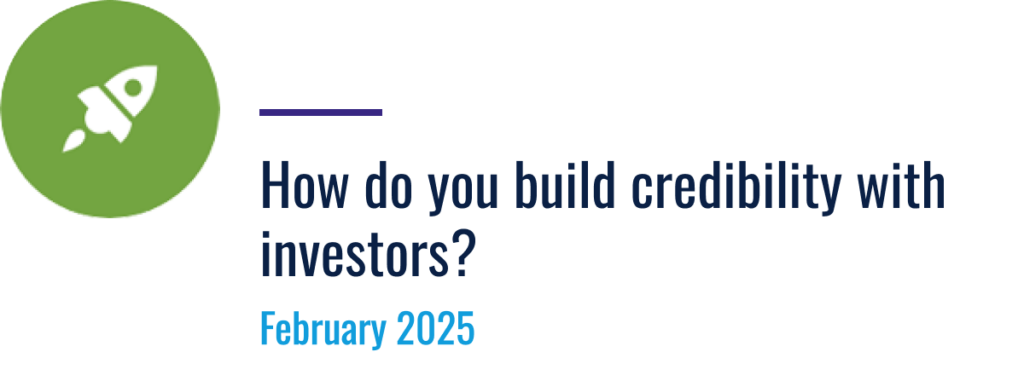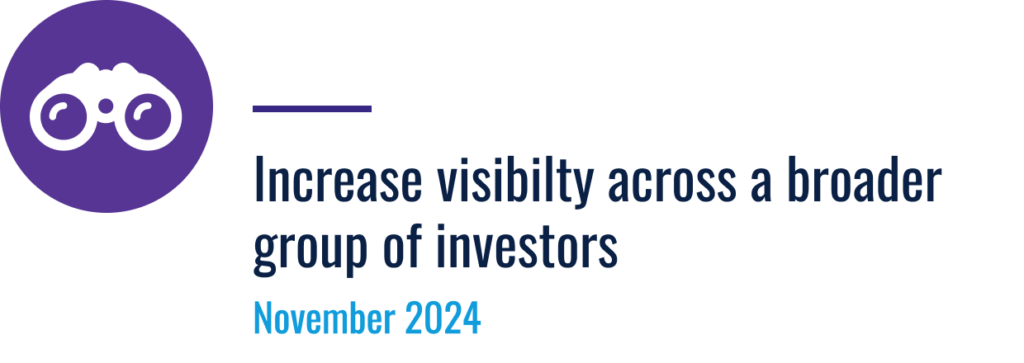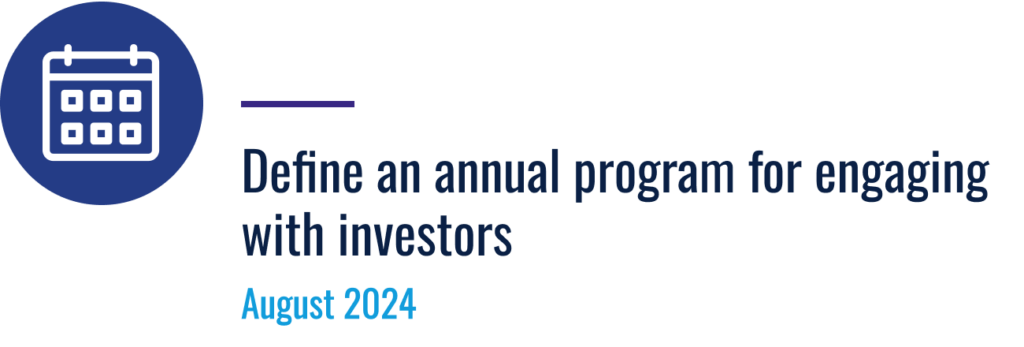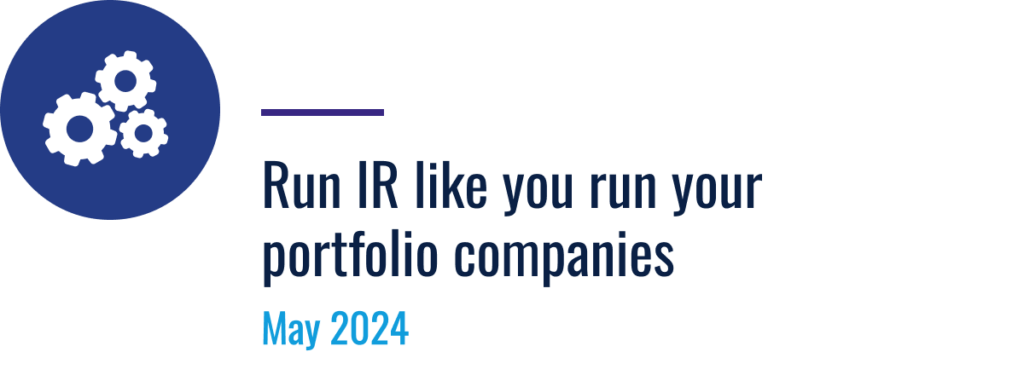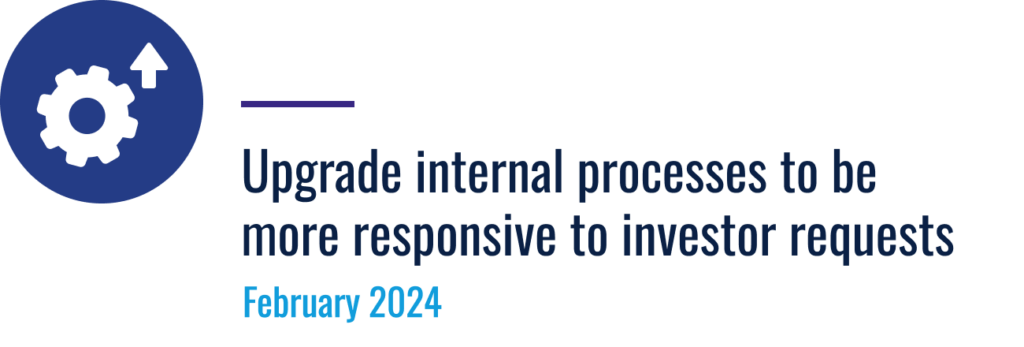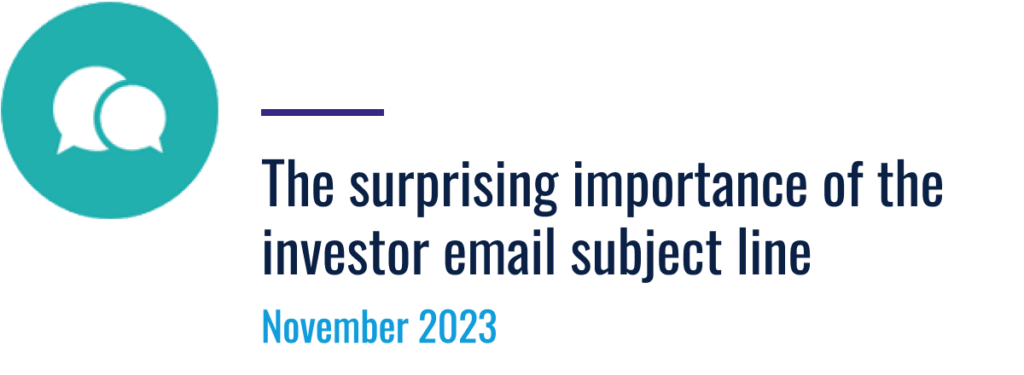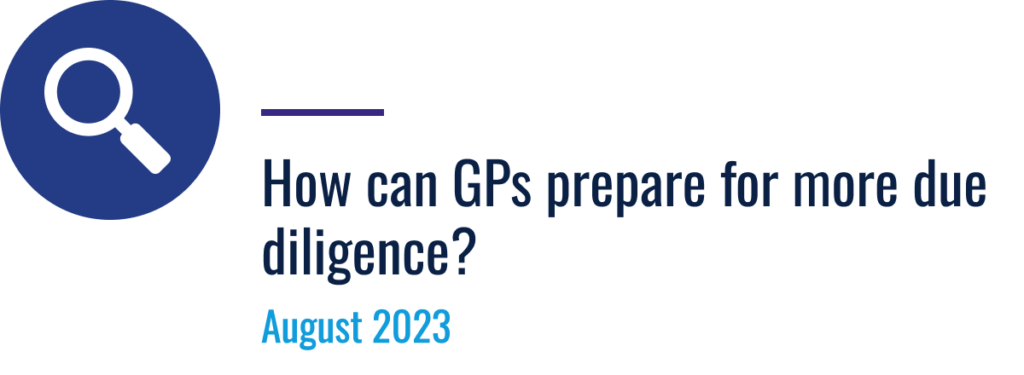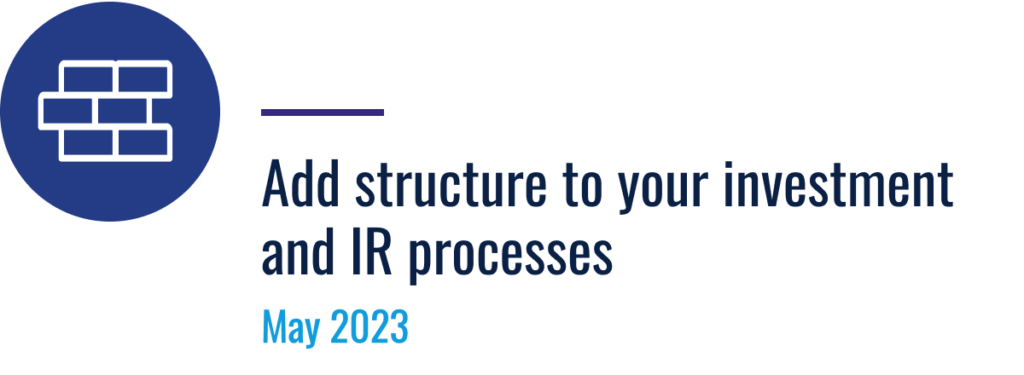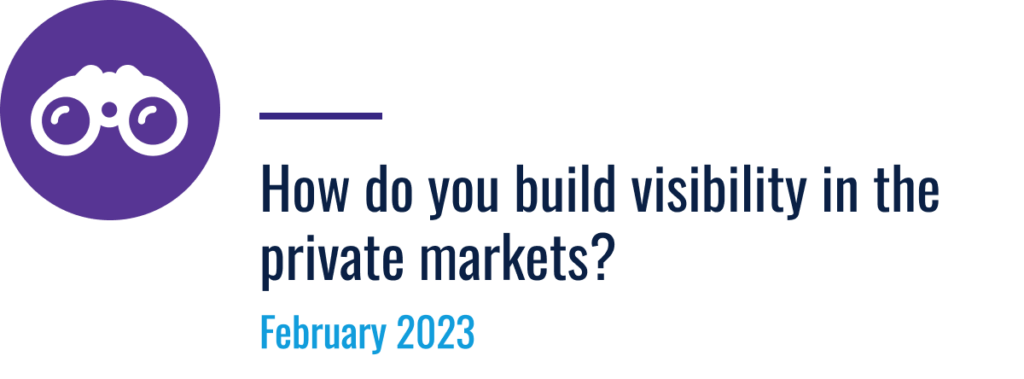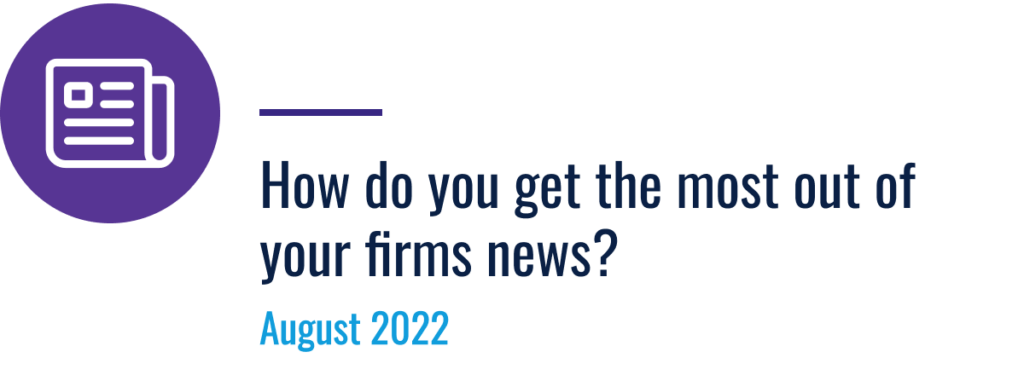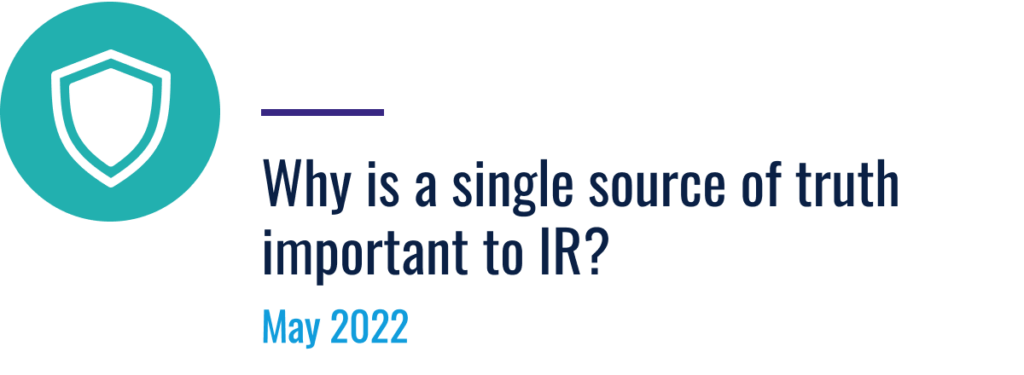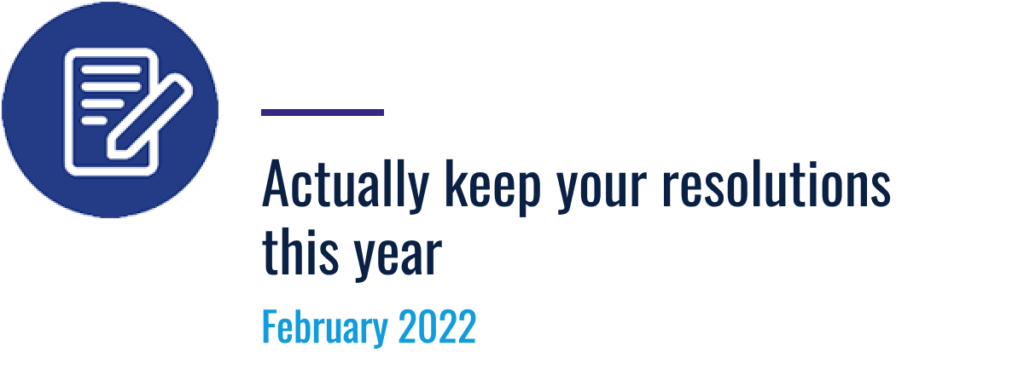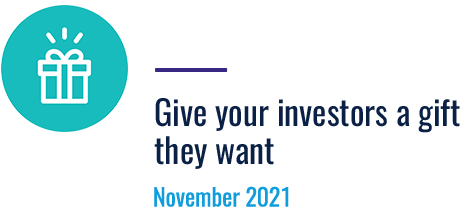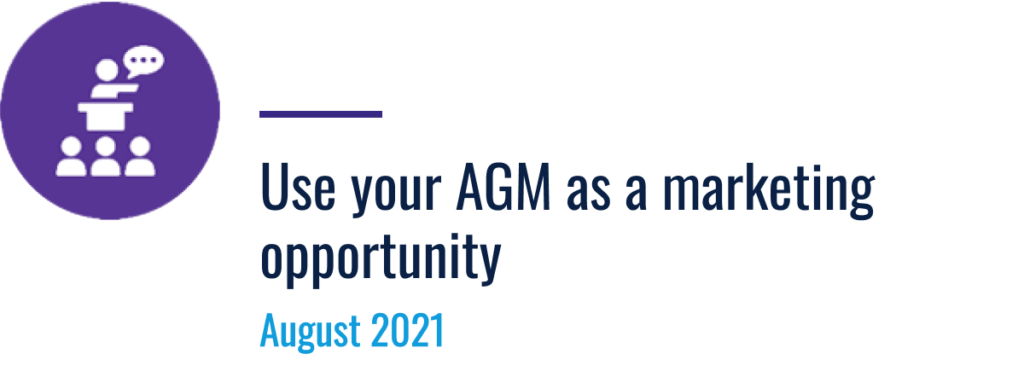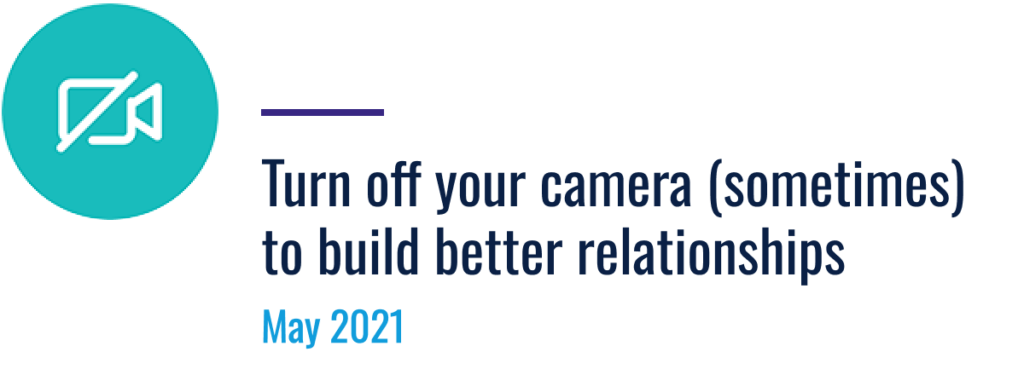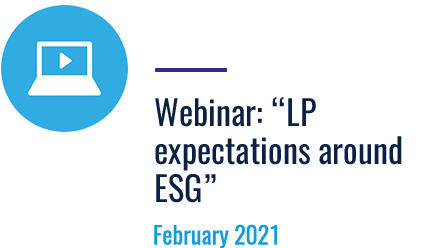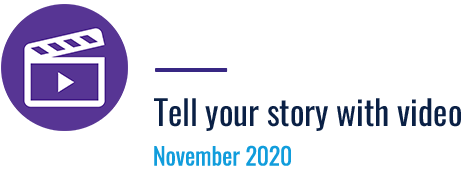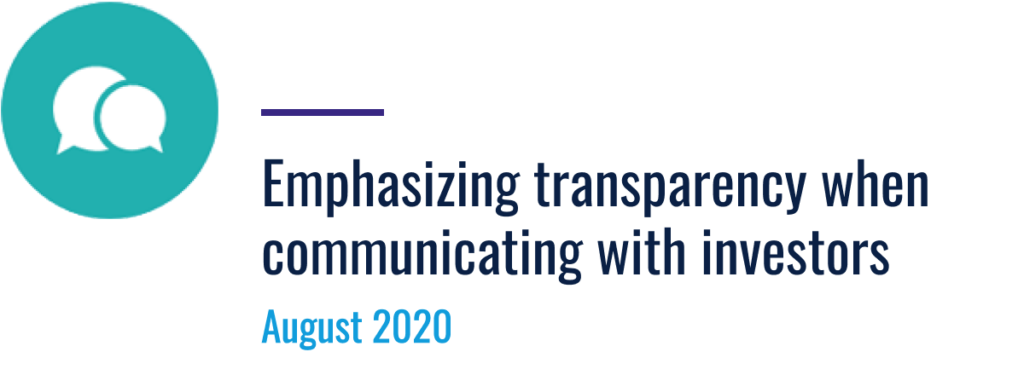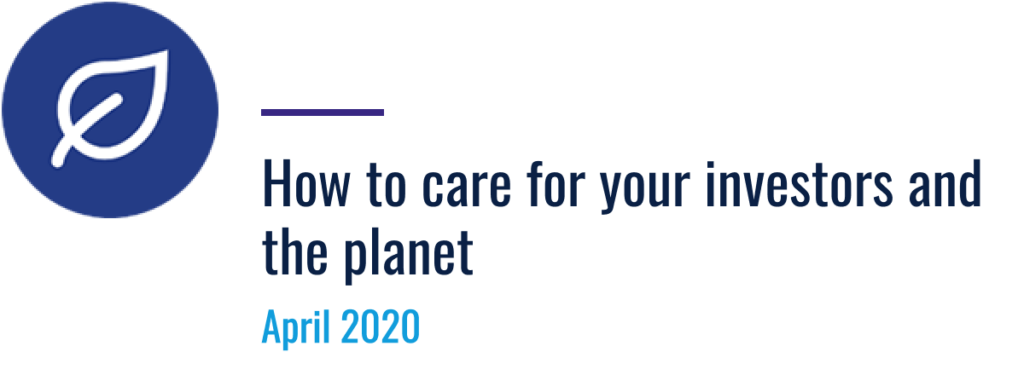INVESTOR RELATIONS
INSIGHTS
![]()
InRider’s years of experience in internal IR and outsourced IR advisory has led to many InSights. Each new conversation with a GP highlights common challenges, as well as opportunities to share InRider’s perspectives on building world-class investor relations programs. Click on the links below for bite-size InSights — all of which we look forward to discussing in more depth with you.
Private markets GPs, when it comes to managing investor relationships, one of the easiest things to do is also one of the most important: communicate expectations accurately and thoughtfully. LPs want to be on your side, so make the effort to ensure they feel like part of your team.
- Set realistic and transparent fundraising timelines. The sooner you get on investors’ radar, the better your chance of getting a spot in a world of tight allocations. Setting clear expected timing will enable both your team and your LPs to build a unified game plan, and will encourage investors to be direct with you about their timing and plans.
- Get ahead of difficult news. As important as it is to communicate positive expectations, it’s doubly important to manage expectations around difficult news. LPs don’t want to be caught off guard. Work hard to avoid surprises regarding fundraising, mark-downs, and departures. When you expect challenges, preview them with LPs to align their expectations.
A good rule in building investor relationships is No Surprises. While GPs and IR professionals can’t anticipate everything, accurate and thoughtful communication via quarterly letters, email updates, in-person meetings, and calls will manage expectations and minimize surprises. By doing so, you can develop trust and a powerful sense of teamwork with your LPs.
Private markets GPs, when it comes to managing investor relationships, one of the easiest things to do is also one of the most important: communicate expectations accurately and thoughtfully. LPs want to be on your side, so make the effort to ensure they feel like part of your team.
- Set realistic and transparent fundraising timelines. The sooner you get on investors’ radar, the better your chance of getting a spot in a world of tight allocations. Setting clear expected timing will enable both your team and your LPs to build a unified game plan, and will encourage investors to be direct with you about their timing and plans.
- Get ahead of difficult news. As important as it is to communicate positive expectations, it’s doubly important to manage expectations around difficult news. LPs don’t want to be caught off guard. Work hard to avoid surprises regarding fundraising, mark-downs, and departures. When you expect challenges, preview them with LPs to align their expectations.
A good rule in building investor relationships is No Surprises. While GPs and IR professionals can’t anticipate everything, accurate and thoughtful communication via quarterly letters, email updates, in-person meetings, and calls will manage expectations and minimize surprises. By doing so, you can develop trust and a powerful sense of teamwork with your LPs.
The final tip from InRider on suggested 2024 investor relations resolutions for private markets GPs: Increase your visibility with more investors. You’ll need to expand your exposure with every fundraise, because *by definition* some of your LPs will not re-up. Here are some ways you can expand your horizons and get noticed by a bigger crowd:
- Be smart about who you target. Not every investor is a fit for your fund strategy, timing, sectors, etc. Research your prospects to make sure you are targeting the right institutions and people. Your time is precious, and relationships take years to build, so research early and start building rapport as soon as possible via in-person and Zoom meetings.
- Use high-impact industry conferences to extend your reach. Your firm’s characteristics will determine which conferences you should attend (emerging manager vs. raising Fund IX). Line up meetings with your target LPs at and around the conference. Consider hosting a dinner. Speak on a panel if the cost is reasonable. Conferences can generate huge value, allowing you to set up meetings in advance and meet multiple LPs efficiently.
- Craft your firm’s public image. LinkedIn is the most active social media platform in our industry, so it’s important to have a strong presence. Sharing news about your firm and portfolio companies will boost your visibility and reinforce your investment strategy. Simply having an active page can raise your credibility and keep you on target investors’ radar.
The final tip from InRider on suggested 2024 investor relations resolutions for private markets GPs: Increase your visibility with more investors. You’ll need to expand your exposure with every fundraise, because *by definition* some of your LPs will not re-up. Here are some ways you can expand your horizons and get noticed by a bigger crowd:
- Be smart about who you target. Not every investor is a fit for your fund strategy, timing, sectors, etc. Research your prospects to make sure you are targeting the right institutions and people. Your time is precious, and relationships take years to build, so research early and start building rapport as soon as possible via in-person and Zoom meetings.
- Use high-impact industry conferences to extend your reach. Your firm’s characteristics will determine which conferences you should attend (emerging manager vs. raising Fund IX). Line up meetings with your target LPs at and around the conference. Consider hosting a dinner. Speak on a panel if the cost is reasonable. Conferences can generate huge value, allowing you to set up meetings in advance and meet multiple LPs efficiently.
- Craft your firm’s public image. LinkedIn is the most active social media platform in our industry, so it’s important to have a strong presence. Sharing news about your firm and portfolio companies will boost your visibility and reinforce your investment strategy. Simply having an active page can raise your credibility and keep you on target investors’ radar.
We kicked off 2024 with some ideas on how private markets GPs could improve their investor relationships. Now, let’s talk about how to create a yearly plan for keeping in touch with your current and prospective LPs.
You can’t just wing it when it comes to LP communications. Best practice is to develop an annual calendar that drives engagement with both LPs and prospective investors. This calendar should not just be a list of dates but rather a living platform that enables you to plan outreach while also tracking the strength of your connectivity with each investor.
To build the annual plan, you will need to decide how frequently you should speak with each investor, as well as who on your team should be the point person for that investor. By engaging a broader group of investment professionals in LP relationship management, you can really show the depth of your firm.
Include any specific reporting requirements or communications requested by LPs in the annual plan (and ideally track these in your CRM as well). These could affect your outreach cadence to those LPs, so it’s best to plan ahead for the year.
Finally, decide which meetings are face-to-face and which ones are online. This will depend on the context, content, and the investor’s preference. Take advantage of in-person connections when possible to build rapport and check each investor’s satisfaction with the relationship.
We kicked off 2024 with some ideas on how private markets GPs could improve their investor relationships. Now, let’s talk about how to create a yearly plan for keeping in touch with your current and prospective LPs.
You can’t just wing it when it comes to LP communications. Best practice is to develop an annual calendar that drives engagement with both LPs and prospective investors. This calendar should not just be a list of dates but rather a living platform that enables you to plan outreach while also tracking the strength of your connectivity with each investor.
To build the annual plan, you will need to decide how frequently you should speak with each investor, as well as who on your team should be the point person for that investor. By engaging a broader group of investment professionals in LP relationship management, you can really show the depth of your firm.
Include any specific reporting requirements or communications requested by LPs in the annual plan (and ideally track these in your CRM as well). These could affect your outreach cadence to those LPs, so it’s best to plan ahead for the year.
Finally, decide which meetings are face-to-face and which ones are online. This will depend on the context, content, and the investor’s preference. Take advantage of in-person connections when possible to build rapport and check each investor’s satisfaction with the relationship.
As a continuation of our 2024 IR Resolutions Series, we believe your approach to IR should be as deliberate as your investment process.
- Process makes perfect: Would you let your portfolio company run without clear processes or KPIs? Utilize your team, project management software, and your CRM to plan, execute, and track everything from marketing material updates, to individual outreach, to your AGM. Always look for opportunities to streamline IR processes.
- Understand industry best practice: Would you allow your portfolio companies to just assume they are already best in class? Research how successful competitors handle IR and understand what is “best practice.” Identify and implement the highest impact components for your firm.
- Senior engagement: Would you let your portfolio companies move forward without strong senior alignment? Support and partnership from senior members of the investment team are essential to building a high-quality IR program. Because IR represents the voice of the firm to both existing and potential LPs, active internal dialogue is a must.
As a continuation of our 2024 IR Resolutions Series, we believe your approach to IR should be as deliberate as your investment process.
- Process makes perfect: Would you let your portfolio company run without clear processes or KPIs? Utilize your team, project management software, and your CRM to plan, execute, and track everything from marketing material updates, to individual outreach, to your AGM. Always look for opportunities to streamline IR processes.
- Understand industry best practice: Would you allow your portfolio companies to just assume they are already best in class? Research how successful competitors handle IR and understand what is “best practice.” Identify and implement the highest impact components for your firm.
- Senior engagement: Would you let your portfolio companies move forward without strong senior alignment? Support and partnership from senior members of the investment team are essential to building a high-quality IR program. Because IR represents the voice of the firm to both existing and potential LPs, active internal dialogue is a must.
In 2024, we are going to give you some “resolutions” that private markets GPs can make to improve their investor relationships. We are starting with upgrading processes to be more responsive to investor requests. Preparation can help you deliver a best-in-class experience to your LPs:
- Streamline your portfolio company data by collecting it in a single spreadsheet. This will allow investor inquiries to be answered more quickly. Many of the buyout and growth equity GPs we work with utilize the Institutional Limited Partners Association (ILPA) Portfolio Company Metrics template as a starting point. Work with your investment and finance team to make sure that the data is updated quarterly and accessible to everyone responding to LP queries.
- Build a robust data room to preemptively address questions. This includes a detailed DDQ that covers most of what LPs have in their own DDQ templates. Including a robust selection of portfolio- and performance-related documents can preempt many investor questions. Take care to name all data room documents in the most obvious way possible. The data and documents are only useful if the investors can actually find them!
- For your existing LPs, make their lives easier with a comprehensive and easily accessible investor portal. You can consolidate all reporting, announcements, notifications, and relevant portfolio company information here. Ad hoc information requests should become less frequent (and therefore less time-consuming) as LPs become accustomed to the thorough and relevant information you are posting.
In 2024, we are going to give you some “resolutions” that private markets GPs can make to improve their investor relationships. We are starting with upgrading processes to be more responsive to investor requests. Preparation can help you deliver a best-in-class experience to your LPs:
- Streamline your portfolio company data by collecting it in a single spreadsheet. This will allow investor inquiries to be answered more quickly. Many of the buyout and growth equity GPs we work with utilize the Institutional Limited Partners Association (ILPA) Portfolio Company Metrics template as a starting point. Work with your investment and finance team to make sure that the data is updated quarterly and accessible to everyone responding to LP queries.
- Build a robust data room to preemptively address questions. This includes a detailed DDQ that covers most of what LPs have in their own DDQ templates. Including a robust selection of portfolio- and performance-related documents can preempt many investor questions. Take care to name all data room documents in the most obvious way possible. The data and documents are only useful if the investors can actually find them!
- For your existing LPs, make their lives easier with a comprehensive and easily accessible investor portal. You can consolidate all reporting, announcements, notifications, and relevant portfolio company information here. Ad hoc information requests should become less frequent (and therefore less time-consuming) as LPs become accustomed to the thorough and relevant information you are posting.
In the world of private markets (and plenty of other industries too), we’re communicating constantly via email. While the sender tends to focus on the body of the email, the subject line plays a huge role in ensuring the recipient actually reads it.
Write a clear, concise subject to make sure that your LPs read the emails you have spent so much time on, for example:
(Meh) XYZ Capital Partners 2023 Annual Meeting Invitation
(Good) Please RSVP: XYZ 2023 AGM → call to action, shorter
(Meh) XYZ Capital Partners Quarterly Report
(Good) XYZ Q2 2023 Report → abbreviated, clear date information
(Meh) XYZ Capital Partners Fund III – closing notice
(Good) XYZ Fund III final close on $750M → the point of the email is in the subject
Apply basic principles to create good subject lines…
- Keep it short and get to the important point within the first three words (abbreviations are your friend). Longer subject lines may not show completely in your recipient’s email preview.
- Include the call to action in the subject line where relevant: PLS REVIEW; RSVP; Approval needed.
- Make sure the subject states what the reader can expect from the email, rather than a generic phrase (i.e. the dreaded “Quick Question” or “Catch-up” subject lines).
- If you’re replying to an older email and changing the conversation, change the subject line to reflect the new topic. You can do this when forwarding emails too!
Just slightly altering your mindset when you’re crafting a subject line can pay off with higher open rates and faster responses, and you will be known across LPs as being a clear communicator.
In the world of private markets (and plenty of other industries too), we’re communicating constantly via email. While the sender tends to focus on the body of the email, the subject line plays a huge role in ensuring the recipient actually reads it.
Write a clear, concise subject to make sure that your LPs read the emails you have spent so much time on, for example:
(Meh) XYZ Capital Partners 2023 Annual Meeting Invitation
(Good) Please RSVP: XYZ 2023 AGM → call to action, shorter
(Meh) XYZ Capital Partners Quarterly Report
(Good) XYZ Q2 2023 Report → abbreviated, clear date information
(Meh) XYZ Capital Partners Fund III – closing notice
(Good) XYZ Fund III final close on $750M → the point of the email is in the subject
Apply basic principles to create good subject lines…
- Keep it short and get to the important point within the first three words (abbreviations are your friend). Longer subject lines may not show completely in your recipient’s email preview.
- Include the call to action in the subject line where relevant: PLS REVIEW; RSVP; Approval needed.
- Make sure the subject states what the reader can expect from the email, rather than a generic phrase (i.e. the dreaded “Quick Question” or “Catch-up” subject lines).
- If you’re replying to an older email and changing the conversation, change the subject line to reflect the new topic. You can do this when forwarding emails too!
Just slightly altering your mindset when you’re crafting a subject line can pay off with higher open rates and faster responses, and you will be known across LPs as being a clear communicator.
Are LPs increasing their due diligence on private markets funds? Yes, yes they are. Coller Capital’s recent Barometer showed that the strong trend across regions is more intensive diligence before investing. How can a GP prepare for that?
- Build a robust data room to preemptively address questions. InRider Partners uses a thorough data room architecture developed over many fundraises. This includes a detailed DDQ that covers most of what LPs have in their own DDQ templates. Pro tip: Rename the documents to make the content obvious, so investors can find what they are looking for.
- Put in the work to aggregate data. Collecting all relevant portco data in a single spreadsheet will streamline LP research. The Institutional Limited Partners Association (ILPA) Portfolio Company Metrics template is a great starting point for buyout and growth equity – use the columns relevant to your portfolio.
- Offer Due Diligence Days. You can maintain some control over your schedule by scheduling on-site DD Days. Set the dates a couple of months in advance, ensure you have everyone in the office and ready to discuss specific deals, and you will address 95% of on-site requests on your terms.
There are many more tricks of the trade, but these three suggestions should go a long way to making the increased due diligence manageable as you are on your way to a successful fundraise.
Now let’s talk about back-pocket information. This is your trick for being oh-so-prepared in investor meetings and making sure that your whole team gives consistent answers. Back-pocket materials are not for wide distribution but can be used in meetings and phone calls. Put in the time and thought to have these ready:
- FAQs (aka Nasty Questions) are tricky questions that you anticipate, often relating to departures, underperforming deals, off-strategy deals, or strategy shifts. Prepare internal-use-only talking points to ensure investor-facing individuals answer these clearly and consistently.
- Prior track record and attribution may not be something you can distribute, but you will need crisp answers about capital deployed, returns, and your team’s roles on those deals. A one-page summary to use in in-person meetings is ideal.
- Performance analytics that make your case are helpful to have on hand. For example, do you need to show the track record without a departed partner’s deals? If it is a point you want to make in meetings, prepare the analysis ahead of time.
- Team alignment should address carry allocation. For larger teams, a one-pager that shows carry split and potentially carry shift from prior funds could be shown, when needed, in in-person meetings.
- Succession planning is likely to come up if any of the managing partners are over 55. At a minimum, agree on talking points. You may also want a written succession plan in your back pocket.
- Operating budget may be requested by investors, particularly when diligencing newer teams. While we don’t recommend broadly sharing your budget, make sure you have the numbers to back up any off-market Fund terms.
Are LPs increasing their due diligence on private markets funds? Yes, yes they are. Coller Capital’s recent Barometer showed that the strong trend across regions is more intensive diligence before investing. How can a GP prepare for that?
- Build a robust data room to preemptively address questions. InRider Partners uses a thorough data room architecture developed over many fundraises. This includes a detailed DDQ that covers most of what LPs have in their own DDQ templates. Pro tip: Rename the documents to make the content obvious, so investors can find what they are looking for.
- Put in the work to aggregate data. Collecting all relevant portco data in a single spreadsheet will streamline LP research. The Institutional Limited Partners Association (ILPA) Portfolio Company Metrics template is a great starting point for buyout and growth equity – use the columns relevant to your portfolio.
- Offer Due Diligence Days. You can maintain some control over your schedule by scheduling on-site DD Days. Set the dates a couple of months in advance, ensure you have everyone in the office and ready to discuss specific deals, and you will address 95% of on-site requests on your terms.
There are many more tricks of the trade, but these three suggestions should go a long way to making the increased due diligence manageable as you are on your way to a successful fundraise.
Now let’s talk about back-pocket information. This is your trick for being oh-so-prepared in investor meetings and making sure that your whole team gives consistent answers. Back-pocket materials are not for wide distribution but can be used in meetings and phone calls. Put in the time and thought to have these ready:
- FAQs (aka Nasty Questions) are tricky questions that you anticipate, often relating to departures, underperforming deals, off-strategy deals, or strategy shifts. Prepare internal-use-only talking points to ensure investor-facing individuals answer these clearly and consistently.
- Prior track record and attribution may not be something you can distribute, but you will need crisp answers about capital deployed, returns, and your team’s roles on those deals. A one-page summary to use in in-person meetings is ideal.
- Performance analytics that make your case are helpful to have on hand. For example, do you need to show the track record without a departed partner’s deals? If it is a point you want to make in meetings, prepare the analysis ahead of time.
- Team alignment should address carry allocation. For larger teams, a one-pager that shows carry split and potentially carry shift from prior funds could be shown, when needed, in in-person meetings.
- Succession planning is likely to come up if any of the managing partners are over 55. At a minimum, agree on talking points. You may also want a written succession plan in your back pocket.
- Operating budget may be requested by investors, particularly when diligencing newer teams. While we don’t recommend broadly sharing your budget, make sure you have the numbers to back up any off-market Fund terms.
Adding structure is like your gameplan ahead of the championship: a careful program that if enthusiastically implemented can lead to victory. Here are high-impact opportunities to use structure to increase your success with investors:
- Investment processes – Your LPs’ perception of your investment process can define their entire view of your firm. Clarifying and codifying each step will allow your firm to deliver consistent messaging and will aid your investors’ due diligence during your next fundraise.
- IR processes – Systematize how you’re reaching out to existing and prospective investors. Think of how you would want your portfolio companies to manage their marketing and apply that expectation to your own firm. Always be on the lookout for new ways to leverage technology.
- CRM Processes – LP communication can break down quickly if not properly tracked. Your CRM should be a centralized resource that serves as the engine driving your investor connectivity. Install a CRM system that fits your firm and make sure people are using it.
- IR communication structure – Duplicated effort is a drain on the whole firm, so be sure to build your LP outreach process on a strong backbone of customizable templates. This will allow your team to quickly and efficiently share important information.
Adding structure is like your gameplan ahead of the championship: a careful program that if enthusiastically implemented can lead to victory. Here are high-impact opportunities to use structure to increase your success with investors:
- Investment processes – Your LPs’ perception of your investment process can define their entire view of your firm. Clarifying and codifying each step will allow your firm to deliver consistent messaging and will aid your investors’ due diligence during your next fundraise.
- IR processes – Systematize how you’re reaching out to existing and prospective investors. Think of how you would want your portfolio companies to manage their marketing and apply that expectation to your own firm. Always be on the lookout for new ways to leverage technology.
- CRM Processes – LP communication can break down quickly if not properly tracked. Your CRM should be a centralized resource that serves as the engine driving your investor connectivity. Install a CRM system that fits your firm and make sure people are using it.
- IR communication structure – Duplicated effort is a drain on the whole firm, so be sure to build your LP outreach process on a strong backbone of customizable templates. This will allow your team to quickly and efficiently share important information.
Visibility is critically important to building investor relationships but tricky in the world of private markets. After all, our funds are, by definition, private. As firms don’t get visibility through mass media, how can GPs creatively promote their expertise and their strategies?
- Understand what your competitors are doing to raise their profiles. What kind of content do they put out on their website? How do they leverage LinkedIn or other social media? Analyze your competition to identify some easy visibility upgrades, like reposting your portfolio companies’ good news on LinkedIn.
- Develop short whitepapers (2-5 pages on a thematic topic) to demonstrate your expertise and build connections. Whitepapers are a great complement to your fund marketing, allowing you to provide thought leadership while not explicitly talking about your current fundraise.
- Make your partners available as expert speakers, whether at high-profile industry conferences (SuperReturn, for example) or to industry journalists working on articles. Private markets GPs tend to focus PR efforts on their portfolio companies, underinvesting in promoting their own expertise.
While high visibility across the investor community can’t make up for poorly articulated processes or a weak track record, these steps can build your credibility and mindshare with potential LPs-as well as with prospective portfolio companies.
Visibility is critically important to building investor relationships but tricky in the world of private markets. After all, our funds are, by definition, private. As firms don’t get visibility through mass media, how can GPs creatively promote their expertise and their strategies?
- Understand what your competitors are doing to raise their profiles. What kind of content do they put out on their website? How do they leverage LinkedIn or other social media? Analyze your competition to identify some easy visibility upgrades, like reposting your portfolio companies’ good news on LinkedIn.
- Develop short whitepapers (2-5 pages on a thematic topic) to demonstrate your expertise and build connections. Whitepapers are a great complement to your fund marketing, allowing you to provide thought leadership while not explicitly talking about your current fundraise.
- Make your partners available as expert speakers, whether at high-profile industry conferences (SuperReturn, for example) or to industry journalists working on articles. Private markets GPs tend to focus PR efforts on their portfolio companies, underinvesting in promoting their own expertise.
While high visibility across the investor community can’t make up for poorly articulated processes or a weak track record, these steps can build your credibility and mindshare with potential LPs-as well as with prospective portfolio companies.
• Team depth – AGMs are a great place to showcase the depth and diversity of your talent. Give brief speaking roles to strong upcoming professionals who don’t get as much facetime with investors
• Culture – This is your opportunity to ‘show’ your culture. Do so by encouraging natural interplay between team members. Avoid erring on the overly formal side — humor is good!
• Short & sweet – Depending on your fund platform, AGMs need not be more than 2 to 3 hours. Focus on new investments and those that have had material developments over the year
• Video/virtual/hybrid – In-person is most effective; hybrid is most challenging. AGMs are about engagement as much as about updates, so encourage investors to attend in-person by offering interaction that they cannot get virtually. Consider recording the AGM to share in your data room if you will soon be fundraising
• Switch it up – Capture attention and keep the event moving by mixing up the speakers and employing different formats, including short videos and fireside chats with CEOs. Consider creative ways to incorporate products or services from portfolio companies
• Practice. Practice. Practice. – No more reading notes in front of your zoom camera. Notes are fine; reading line-by-line is not. Engage a speaker coach if necessary to nail delivery
• Networking events – The happy return of the cocktail hour! Ensure there are inclusive and fun networking events, whether it is simply drinks, a more formal dinner or an outdoor activity. Attendees are there to learn and to mingle
• External speakers – Consensus is they are not required. Unless you have a speaker that is directly relevant to your portfolio, save the money and use that valuable time to talk about your firm
• Team depth – AGMs are a great place to showcase the depth and diversity of your talent. Give brief speaking roles to strong upcoming professionals who don’t get as much facetime with investors
• Culture – This is your opportunity to ‘show’ your culture. Do so by encouraging natural interplay between team members. Avoid erring on the overly formal side — humor is good!
• Short & sweet – Depending on your fund platform, AGMs need not be more than 2 to 3 hours. Focus on new investments and those that have had material developments over the year
• Video/virtual/hybrid – In-person is most effective; hybrid is most challenging. AGMs are about engagement as much as about updates, so encourage investors to attend in-person by offering interaction that they cannot get virtually. Consider recording the AGM to share in your data room if you will soon be fundraising
• Switch it up – Capture attention and keep the event moving by mixing up the speakers and employing different formats, including short videos and fireside chats with CEOs. Consider creative ways to incorporate products or services from portfolio companies
• Practice. Practice. Practice. – No more reading notes in front of your zoom camera. Notes are fine; reading line-by-line is not. Engage a speaker coach if necessary to nail delivery
• Networking events – The happy return of the cocktail hour! Ensure there are inclusive and fun networking events, whether it is simply drinks, a more formal dinner or an outdoor activity. Attendees are there to learn and to mingle
• External speakers – Consensus is they are not required. Unless you have a speaker that is directly relevant to your portfolio, save the money and use that valuable time to talk about your firm
Private markets GPs, are you struggling to get your achievements noticed by your target audience? With investors being inundated with information in all forms including hundreds of e-mails from GPs alone, it’s becoming increasingly difficult to stand out in a crowded landscape. But fear not, there are ways to cut through the noise and make sure your portfolio updates, new hires, conference speaking engagements, and other important news are heard loud and clear.
- Utilize all the channels available to you. Don’t limit communication to the standard default of mass email, press releases, and website updates. To stand out, consider short case study webinars or regular between-fundraising roadshows to cities where you have a high concentration of investors and prospects. Additionally, the impact of short update phone calls cannot be understated. Finally, be sure to integrate LinkedIn into your communications ecosystem and use it regularly
- Keep things brief and to the point. Your LPs are busy people and don’t have time to sift through a wall of text any more than you do. Make sure you’re condensing and conveying the important information and remember to never bury the lede. Your LPs will thank you for the efficient communication and respect for their time
- Curate your target audience. Take the time to ensure your communications are going to the right people. Regularly review e-mail distribution lists, connect with your target audience on LinkedIn (both personally and via your firm’s LinkedIn site), and update your CRM system immediately when you learn of promotions, new hires, and departure
- Presentation counts. While content is king, thoughtful design and appearance can drive the impact of your message. A well-designed email, document, or website will not only keep your readers engaged but will also boost the overall strength of your brand. By that same token, poorly designed communication can hurt your credibility
Put an emphasis on crafting concise and well-presented messages that showcase your successes and important announcements. By driving engagement with your target audience in the most effective way, you’ll build a more aligned network for your firm while making sure your achievements are seen and heard by the right people.
Private markets GPs, are you struggling to get your achievements noticed by your target audience? With investors being inundated with information in all forms including hundreds of e-mails from GPs alone, it’s becoming increasingly difficult to stand out in a crowded landscape. But fear not, there are ways to cut through the noise and make sure your portfolio updates, new hires, conference speaking engagements, and other important news are heard loud and clear.
- Utilize all the channels available to you. Don’t limit communication to the standard default of mass email, press releases, and website updates. To stand out, consider short case study webinars or regular between-fundraising roadshows to cities where you have a high concentration of investors and prospects. Additionally, the impact of short update phone calls cannot be understated. Finally, be sure to integrate LinkedIn into your communications ecosystem and use it regularly
- Keep things brief and to the point. Your LPs are busy people and don’t have time to sift through a wall of text any more than you do. Make sure you’re condensing and conveying the important information and remember to never bury the lede. Your LPs will thank you for the efficient communication and respect for their time
- Curate your target audience. Take the time to ensure your communications are going to the right people. Regularly review e-mail distribution lists, connect with your target audience on LinkedIn (both personally and via your firm’s LinkedIn site), and update your CRM system immediately when you learn of promotions, new hires, and departure
- Presentation counts. While content is king, thoughtful design and appearance can drive the impact of your message. A well-designed email, document, or website will not only keep your readers engaged but will also boost the overall strength of your brand. By that same token, poorly designed communication can hurt your credibility
Put an emphasis on crafting concise and well-presented messages that showcase your successes and important announcements. By driving engagement with your target audience in the most effective way, you’ll build a more aligned network for your firm while making sure your achievements are seen and heard by the right people.
Data Accuracy is essential in private markets investor relations. To respond to investor requests, accuracy needs to be combined with consistency and efficiency. How do you do that successfully? By having all information centralized and readily available via a firm-wide single source of truth.
Here’s what that looks like for private markets IR:
- Work with your investment and finance team to centralize all portfolio and fund data. Make sure that the data is updated real-time or at least quarterly. Data should be in a format that can be easily sliced to address most frequent LP requests, and directly accessible by the IR team.
- Make your LPs’ lives easy: provide a comprehensive and easily accessible investor portal with all reporting, announcements, notifications, and relevant portfolio company information. As LPs become accustomed to the thorough information you are posting, one-off information requests should become less frequent and less time-consuming.
- Ensure consistency across documents and messaging. Without consistency, credibility will be compromised if investors hear conflicting information. Ensure all numbers tie and every investor-facing individual knows answers to frequently asked questions.
A single source of truth is especially important during fundraising, when time is limited and there is no margin for error. When you’re not in the market, being able to quickly provide accurate, thoughtful responses that meet your LPs’ needs will enable you to build credibility and ultimately strong partnerships with investors.
Data Accuracy is essential in private markets investor relations. To respond to investor requests, accuracy needs to be combined with consistency and efficiency. How do you do that successfully? By having all information centralized and readily available via a firm-wide single source of truth.
Here’s what that looks like for private markets IR:
- Work with your investment and finance team to centralize all portfolio and fund data. Make sure that the data is updated real-time or at least quarterly. Data should be in a format that can be easily sliced to address most frequent LP requests, and directly accessible by the IR team.
- Make your LPs’ lives easy: provide a comprehensive and easily accessible investor portal with all reporting, announcements, notifications, and relevant portfolio company information. As LPs become accustomed to the thorough information you are posting, one-off information requests should become less frequent and less time-consuming.
- Ensure consistency across documents and messaging. Without consistency, credibility will be compromised if investors hear conflicting information. Ensure all numbers tie and every investor-facing individual knows answers to frequently asked questions.
A single source of truth is especially important during fundraising, when time is limited and there is no margin for error. When you’re not in the market, being able to quickly provide accurate, thoughtful responses that meet your LPs’ needs will enable you to build credibility and ultimately strong partnerships with investors.
It’s a new year, which means you’re likely setting out to achieve some new goals. For those related to your investor relationships, InRider Partners can make it easy for you by helping you:
• Focus on your day job – Do you need to focus on investing instead of getting pulled into investor relations? We can help you outsource or streamline your IR strategy.
• Ramp up your ESG program – Thinking about ESG but don’t know where to start? We can guide you through a step-by-step ESG program designed for mid- to small-size GPs
• Make a real impact with your strategy and messaging – ‘Fundraising success will depend on the clarity of the message,’ according to Intralinks’ recent report. InRider will work with you to ensure your investment proposition is powerful, your materials are high impact, and that you get your investors’ attention.
• Strengthen investor relationships – What do investors REALLY want? Work with InRider on a targeted investor survey that will yield a comprehensive investor engagement plan.
• Actually do between-fund marketing (don’t just think about it) – Get ahead of your next fundraise by being proactive in 2022. We will partner with you to prioritize investor initiatives and communications that will pave the way to a smoother next fundraise.
• Deliver your best-ever AGM – ‘Same-old’ isn’t going to cut it, even with new virtual options. We can help you stand out and engage your LPs.
Let InRider help you stick to your 2022 goals by providing the support you need to be successful this year (and for years to come)!
It’s a new year, which means you’re likely setting out to achieve some new goals. For those related to your investor relationships, InRider Partners can make it easy for you by helping you:
• Focus on your day job – Do you need to focus on investing instead of getting pulled into investor relations? We can help you outsource or streamline your IR strategy.
• Ramp up your ESG program – Thinking about ESG but don’t know where to start? We can guide you through a step-by-step ESG program designed for mid- to small-size GPs
• Make a real impact with your strategy and messaging – ‘Fundraising success will depend on the clarity of the message,’ according to Intralinks’ recent report. InRider will work with you to ensure your investment proposition is powerful, your materials are high impact, and that you get your investors’ attention.
• Strengthen investor relationships – What do investors REALLY want? Work with InRider on a targeted investor survey that will yield a comprehensive investor engagement plan.
• Actually do between-fund marketing (don’t just think about it) – Get ahead of your next fundraise by being proactive in 2022. We will partner with you to prioritize investor initiatives and communications that will pave the way to a smoother next fundraise.
• Deliver your best-ever AGM – ‘Same-old’ isn’t going to cut it, even with new virtual options. We can help you stand out and engage your LPs.
Let InRider help you stick to your 2022 goals by providing the support you need to be successful this year (and for years to come)!
As the US celebrates Thanksgiving, InRider Partners is thinking about the best way for GPs to thank their investors. While gifts can say thank you (more below), we suggest other meaningful ways to show appreciation.
First, let’s talk about gifts… Whether you are thinking about holiday gifts or AGM swag, consider two questions:
1. In the words of Marie Kondo, will this gift spark joy or will it end up in a drawer or in the trash?
2. Is this gift distinctive? If you plan to send a branded hat, charger, notebook, or run-of-the-mill gift basket, the answer is no. Investors have more of those than they need.
Some standout gifts we’ve seen are specific to a GP’s location (e.g., local food specialty), reflect a GP interest, or are high-quality items (perhaps a product from a portfolio company). Alternatively, consider demonstrating your ESG commitment by selecting a gift that supports your community, a women- or minority-run business, OR is a donation in honor of your LPs.
Physical gifts aside, the best gift you can give busy people is to make their lives easier, which is what InRider suggests for GPs interested in showing gratitude. Here are a few ways to get started:
• Ask your LPs what you can do better! You’ll never know until you ask.
• Enhance your reporting! Most GP reporting would benefit from improved usability, readability, strategy reinforcement, and level of detail.
• Be proactive, not reactive! If you are proactively sharing updates and scheduling meetings with your LPs, they won’t need to ask.
• Make sure your information is getting to the right people! The decision makers at your LPs may not be receiving your carefully prepared information, as it often goes to an ops team or junior resources.
If you’re reading this and wondering when you last did any of the above, consider giving yourself a gift by letting InRider make your life easier. We have worked with GPs on all these fronts by helping to build strong investor relationships through best-practice investor relations strategies. InRider can reach out to investors for feedback, review your existing process and materials, propose upgrades and create improved materials, and more.
As the US celebrates Thanksgiving, InRider Partners is thinking about the best way for GPs to thank their investors. While gifts can say thank you (more below), we suggest other meaningful ways to show appreciation.
First, let’s talk about gifts… Whether you are thinking about holiday gifts or AGM swag, consider two questions:
1. In the words of Marie Kondo, will this gift spark joy or will it end up in a drawer or in the trash?
2. Is this gift distinctive? If you plan to send a branded hat, charger, notebook, or run-of-the-mill gift basket, the answer is no. Investors have more of those than they need.
Some standout gifts we’ve seen are specific to a GP’s location (e.g., local food specialty), reflect a GP interest, or are high-quality items (perhaps a product from a portfolio company). Alternatively, consider demonstrating your ESG commitment by selecting a gift that supports your community, a women- or minority-run business, OR is a donation in honor of your LPs.
Physical gifts aside, the best gift you can give busy people is to make their lives easier, which is what InRider suggests for GPs interested in showing gratitude. Here are a few ways to get started:
• Ask your LPs what you can do better! You’ll never know until you ask.
• Enhance your reporting! Most GP reporting would benefit from improved usability, readability, strategy reinforcement, and level of detail.
• Be proactive, not reactive! If you are proactively sharing updates and scheduling meetings with your LPs, they won’t need to ask.
• Make sure your information is getting to the right people! The decision makers at your LPs may not be receiving your carefully prepared information, as it often goes to an ops team or junior resources.
If you’re reading this and wondering when you last did any of the above, consider giving yourself a gift by letting InRider make your life easier. We have worked with GPs on all these fronts by helping to build strong investor relationships through best-practice investor relations strategies. InRider can reach out to investors for feedback, review your existing process and materials, propose upgrades and create improved materials, and more.
Is there any other single annual event that you put more effort into than your Annual General Meeting?
Yet you’re probably not getting the full impact that you could. With limited additional effort, the AGM becomes a prime marketing opportunity and a chance to endear your team with your LPs. The potential impact is especially great when you are between fundraises. Investors love to look under the hood when they believe that GPs are not pushing a new fund.
Start by asking your LPs what they want to hear at the AGM. That simple inquiry immediately sets your team apart from most GPs, by showing that you care about your LPs’ input to the AGM agenda and that you are open to answering their real questions.
Next, think about the 3 to 4 messages that you want your AGM attendees to take away. These are likely a mix of characteristics that differentiate your team and strategy, and aspects of your process that you want to reinforce. A well-designed AGM means that your LPs go away with a clearer picture of your strategy and why you are in their portfolio.
Finally, make the AGM relevant for prospective LPs by including content that they can learn from. Whether that is your CEO roundtable discussion, distinctive sector knowledge, economic perspective, or strategies for risk management, sharing thought leadership has a positive impact with current and prospective LPs. After all, if you’re going to put in all the effort, you might as well try to pave the way for a successful next fundraise.
Is there any other single annual event that you put more effort into than your Annual General Meeting?
Yet you’re probably not getting the full impact that you could. With limited additional effort, the AGM becomes a prime marketing opportunity and a chance to endear your team with your LPs. The potential impact is especially great when you are between fundraises. Investors love to look under the hood when they believe that GPs are not pushing a new fund.
Start by asking your LPs what they want to hear at the AGM. That simple inquiry immediately sets your team apart from most GPs, by showing that you care about your LPs’ input to the AGM agenda and that you are open to answering their real questions.
Next, think about the 3 to 4 messages that you want your AGM attendees to take away. These are likely a mix of characteristics that differentiate your team and strategy, and aspects of your process that you want to reinforce. A well-designed AGM means that your LPs go away with a clearer picture of your strategy and why you are in their portfolio.
Finally, make the AGM relevant for prospective LPs by including content that they can learn from. Whether that is your CEO roundtable discussion, distinctive sector knowledge, economic perspective, or strategies for risk management, sharing thought leadership has a positive impact with current and prospective LPs. After all, if you’re going to put in all the effort, you might as well try to pave the way for a successful next fundraise.
In private markets fundraising and IR, our priority is being visible to investors. But after 18 months of Zoom, it’s time to give your LPs a break from video! Start thinking strategically about when Zoom is additive and when you can just use phone or audio, and you will gain your LPs’ gratitude for reducing their ZEF rating. (That’s the Zoom Exhaustion & Fatigue Scale, developed by Anna Carolina Queiroz, Ph.D at Stanford University.)
A recent Stanford article outlines simple fixes for the causes of Zoom fatigue. InRider Partners has found these four approaches to be effective for #investorrelations:
1. Do audio-only marketing updates (especially when 1:1) once you’ve done the marketing pitch via video or in person. Remember what it feels like to have a long (audio) call with a close friend? Cultivate close listening and personal anecdotes to build investor friendships using your voice.
2. Get more relaxed and candid input or feedback via (audio) phone. Your investors won’t need to worry about their appearance, and you can focus on taking notes rather than making eye contact.
3. Mark calendar invites clearly as AUDIO or VIDEO so that your investors — and your team — know what to expect. (You can set your meeting settings to default all participants’ videos to be OFF.).
4. Work “walk and talk” calls into your team’s days. Research indicates that we “perform better cognitively” when moving, so put in the noise-canceling ear buds and start your stroll! Works best for internal or informal catch-up calls.
Remember, “just because you CAN use video doesn’t mean you HAVE to,” says Professor Jeremy Bailenson of Stanford’s Virtual Human Interaction Lab. And that goes for all of us in private equity and venture capital. We work in fields where we always want to be “on” and, by doing so, we are unintentionally increasing ZEF for our investors.
Click here to read the full article from Stanford University.
In private markets fundraising and IR, our priority is being visible to investors. But after 18 months of Zoom, it’s time to give your LPs a break from video! Start thinking strategically about when Zoom is additive and when you can just use phone or audio, and you will gain your LPs’ gratitude for reducing their ZEF rating. (That’s the Zoom Exhaustion & Fatigue Scale, developed by Anna Carolina Queiroz, Ph.D at Stanford University.)
A recent Stanford article outlines simple fixes for the causes of Zoom fatigue. InRider Partners has found these four approaches to be effective for #investorrelations:
1. Do audio-only marketing updates (especially when 1:1) once you’ve done the marketing pitch via video or in person. Remember what it feels like to have a long (audio) call with a close friend? Cultivate close listening and personal anecdotes to build investor friendships using your voice.
2. Get more relaxed and candid input or feedback via (audio) phone. Your investors won’t need to worry about their appearance, and you can focus on taking notes rather than making eye contact.
3. Mark calendar invites clearly as AUDIO or VIDEO so that your investors — and your team — know what to expect. (You can set your meeting settings to default all participants’ videos to be OFF.).
4. Work “walk and talk” calls into your team’s days. Research indicates that we “perform better cognitively” when moving, so put in the noise-canceling ear buds and start your stroll! Works best for internal or informal catch-up calls.
Remember, “just because you CAN use video doesn’t mean you HAVE to,” says Professor Jeremy Bailenson of Stanford’s Virtual Human Interaction Lab. And that goes for all of us in private equity and venture capital. We work in fields where we always want to be “on” and, by doing so, we are unintentionally increasing ZEF for our investors.
Click here to read the full article from Stanford University.
CohnReznick, the global accounting firm, recently hosted a webinar to discuss what investors expect from their GPs in terms of ESG programs and reporting. Lots of great questions from the audience, made up of private markets GPs in early stages of their ESG programs. In addition to InRider’s Mona Marquardt, the webinar included StepStone’s Michael Elio, HKW’s Caroline Young, Middleground’s Jamie Meurer, and Claudine Cohen from CohnReznick.
Click here for a written summary and the on-demand video of the webinar.
CohnReznick, the global accounting firm, recently hosted a webinar to discuss what investors expect from their GPs in terms of ESG programs and reporting. Lots of great questions from the audience, made up of private markets GPs in early stages of their ESG programs. In addition to InRider’s Mona Marquardt, the webinar included StepStone’s Michael Elio, HKW’s Caroline Young, Middleground’s Jamie Meurer, and Claudine Cohen from CohnReznick.
Click here for a written summary and the on-demand video of the webinar.
Investors are increasingly interested in learning about fund managers via video, especially in a time without in-person meetings. A carefully crafted video with high-quality graphics can show off your entire team and ensure that the message is delivered exactly as you want. As an example, InRider produced this 3.5-minute video for Turning Rock Partners in connection with their annual meeting and to reintroduce their strategy to the broader investor community.
Click here for the Turning Rock Partners video
Investors are increasingly interested in learning about fund managers via video, especially in a time without in-person meetings. A carefully crafted video with high-quality graphics can show off your entire team and ensure that the message is delivered exactly as you want. As an example, InRider produced this 3.5-minute video for Turning Rock Partners in connection with their annual meeting and to reintroduce their strategy to the broader investor community.
Click here for the Turning Rock Partners video
How do you build credibility with investors? When it comes to marketing private markets funds, strong performance and demonstrable experience are unquestionably important, but credibility is the key to winning new LPs and keeping existing investors. How can you ensure that you are establishing credibility and trust with investors?
- While it’s tempting to shout the good news from the rooftops, investors understand that it’s not always sunshine and rainbows in private markets. Talk about your challenged companies honestly, with a focus on what you’re doing to improve the situation.
- Be humble and transparent about lessons learned across your portfolio. Investors respect GPs who own their missteps. An honest and pragmatic approach can make you stand out during fundraising.
- Avoid over-promoting good news that could change significantly for the worse in the future, as investors will notice the disconnect when you report the updated news.
While it can be uncomfortable to talk about your problem children, proactively and transparently addressing challenges in your portfolio or your team will actually help strengthen your partnership with investors, leading to longer-term success.
How do you build credibility with investors? When it comes to marketing private markets funds, strong performance and demonstrable experience are unquestionably important, but credibility is the key to winning new LPs and keeping existing investors. How can you ensure that you are establishing credibility and trust with investors?
- While it’s tempting to shout the good news from the rooftops, investors understand that it’s not always sunshine and rainbows in private markets. Talk about your challenged companies honestly, with a focus on what you’re doing to improve the situation.
- Be humble and transparent about lessons learned across your portfolio. Investors respect GPs who own their missteps. An honest and pragmatic approach can make you stand out during fundraising.
- Avoid over-promoting good news that could change significantly for the worse in the future, as investors will notice the disconnect when you report the updated news.
While it can be uncomfortable to talk about your problem children, proactively and transparently addressing challenges in your portfolio or your team will actually help strengthen your partnership with investors, leading to longer-term success.
If you’re a private markets IR professional, here are several earth-friendly initiatives to show your investors that you’re creating a greener firm:
Make day-to-day IR activities more environmentally minded…
- Eliminate paper presentations by letting investors view materials on their laptops or load the presentations on iPads.
- Adopt electronic business cards, which are increasingly popular.
- Showcase your team’s ESG-oriented activities, such as park clean-up days.
Your AGM presents lots of opportunities for eco-friendly decision making…
- Use iPads to present your materials electronically.
- Make a charitable donation in the name of your attendees instead of handing out wasteful swag.
- Purchase carbon credits to offset the emissions from your LPs’ travel to the AGM.
- Offer a fully vegetarian menu, both healthy and earth-friendly.
- Opt for recyclable and compostable drink and serveware.
These small steps demonstrate your firm’s commitment, enhance your brand, and help keep sustainability top of mind for your investors and the industry as a whole.
If you’re a private markets IR professional, here are several earth-friendly initiatives to show your investors that you’re creating a greener firm:
Make day-to-day IR activities more environmentally minded…
- Eliminate paper presentations by letting investors view materials on their laptops or load the presentations on iPads.
- Adopt electronic business cards, which are increasingly popular.
- Showcase your team’s ESG-oriented activities, such as park clean-up days.
Your AGM presents lots of opportunities for eco-friendly decision making…
- Use iPads to present your materials electronically.
- Make a charitable donation in the name of your attendees instead of handing out wasteful swag.
- Purchase carbon credits to offset the emissions from your LPs’ travel to the AGM.
- Offer a fully vegetarian menu, both healthy and earth-friendly.
- Opt for recyclable and compostable drink and serveware.
These small steps demonstrate your firm’s commitment, enhance your brand, and help keep sustainability top of mind for your investors and the industry as a whole.
Contact Us

We welcome your inquiry:


